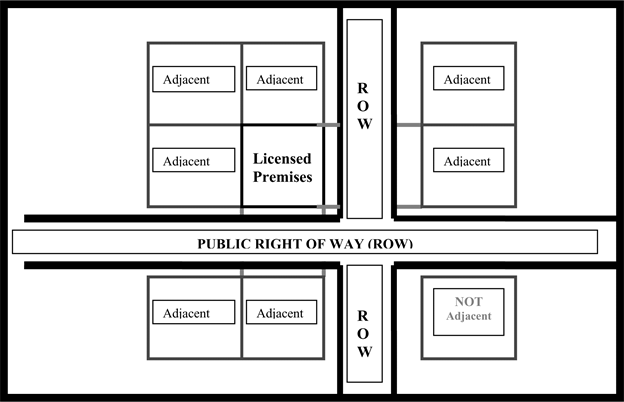PDFWAC 314-02-010
Definitions.
The definitions in this section apply throughout this title unless the context clearly requires otherwise. Additional definitions can be found in RCW 66.04.010.
(1) "Adjacent" means having a common endpoint or border where the extension of the property lines of the licensed premises contacts that common border.
 |
(2) "Banquet room" means any room used primarily for the sale and service of food and liquor to private groups.
(3)(a) "Complete meal" means:
(i) An entree with at least one side dish available to order. Side dishes must be offered and available to order with the entree, but are not required to be included; or
(ii) A combination of small plates that are intended to be ordered many at a time or on a rolling basis throughout the meal service.
(b) Menu items that consist solely of the following types of food do not qualify as complete meals: Precooked frozen meals that are reheated, carry-out items obtained from another business, or snack food.
(c) For the purposes of this subsection, the following definitions apply unless the context clearly requires otherwise:
(i) "Entree" means the main course of a meal. Some examples of entrees include, but are not limited to, fish, steak, chicken, pork, pasta, pizza, burgers, pho, sushi, street tacos, tikka masala, quiche, fufu, curry, seafood salad, Cobb salad, chef's salad, sandwiches, and breakfast items.
(ii) "Side dish" includes soups, vegetables, salads, potatoes, beans, rice, naan, couscous, irio, fruit, bread, banchan, and other similar dishes. Garnishes do not qualify as side dishes. Some examples of garnishes include, but are not limited to, pickles, salsa, and dips.
(iii) "Small plate" means a type of menu item that has a small portion size and is intended to be ordered many at a time or on a rolling basis throughout the meal service. Small plates are often shared among guests. Some examples of small plates include, but are not limited to, tapas, dim sum, and meze. Many cultures have different types of small plates. Small plates do not include snack food.
(4) "Customer service area" means areas where food and/or liquor are normally sold and served to the public, i.e., lounges and dining areas. A banquet room is not considered a customer service area.
(5) "Dedicated dining area." In order for an area to qualify as a dedicated dining area, it must be a distinct portion inside of a restaurant that is used primarily for the sale, service, and consumption of food, and have accommodations for eating, e.g., tables, chairs, booths, etc. See WAC 314-02-025 for more information.
(6) "Designated area" means a space where alcohol may be sold, served, or consumed.
(7) "Entertainer" means someone who performs for an audience such as a disc jockey, singer, or comedian, or anyone providing entertainment services for the licensee. An entertainer is considered an employee of the liquor licensee per WAC 314-01-005. Patrons participating in entertainment are not considered employees.
(8) "Entertainment" means dancing, karaoke, singing, comedy shows, concerts, TV broadcasts, contests with patron participation and/or performing for an audience.
(9) "Food counter" means a table or counter set up for the primary purpose of food service to customers who sit or stand at the counter. Any alcohol served is incidental to food service.
(10) "Game room" means an area of a business set up for the primary purpose of patrons using games or gaming devices.
(11) "Liquor bar" means a table or counter where alcohol is stored or prepared and served to customers who sit or stand at the bar. Liquor bars can only be in lounges or in premises where minors are not allowed at any time.
(12) "Lounge" means the portion of a restaurant used primarily for the preparation, sale, and service of beer, wine, or spirits. Minors are not allowed in a lounge (see RCW 66.44.316 for information on employees and professional musicians under 21 years of age).
(13)(a) "Minimum food service" means that menu items such as sandwiches, salad, soup, pizza, hamburgers, fries, savory pies, tacos, dumplings, fried rice, and other similar items are available to order.
(b) Menu items that consist solely of the following types of food do not qualify as minimum food service: Precooked frozen meals that are reheated, carry-out items obtained from another business, or snack food.
(14) "Minor" means a person under 21 years of age.
(15) "On-premises liquor licensed premises" means a building in which a business is located inside that is allowed to sell alcohol for consumption on the licensed premises.
(16) "Service bar" means a fixed or portable table, counter, cart, or similar work station primarily used to prepare, mix, serve, and sell alcohol that is picked up by employees or customers. Customers may not be seated or allowed to consume food or alcohol at a service bar.
(17) "Snack food" includes items such as peanuts, popcorn, chips, jerky, candy, cookies, crackers, edamame, and other similar food items.
[Statutory Authority: 2021 c 48 § 2, RCW 66.08.071, 66.08.030 and 2021 c 48. WSR 22-01-052, § 314-02-010, filed 12/8/21, effective 1/8/22. Statutory Authority: RCW 66.08.030. WSR 17-12-030, § 314-02-010, filed 5/31/17, effective 7/1/17. Statutory Authority: RCW 66.08.030 and 66.24.363. WSR 11-01-133, § 314-02-010, filed 12/21/10, effective 1/21/11. Statutory Authority: RCW 66.08.030 and 66.24.600. WSR 10-01-091, § 314-02-010, filed 12/16/09, effective 1/16/10. Statutory Authority: RCW 66.08.030 and 66.24.590. WSR 08-17-067, § 314-02-010, filed 8/19/08, effective 9/19/08. Statutory Authority: RCW 66.04.010, 66.08.030, 66.24.410, 66.44.310, and 66.44.420. WSR 05-22-022, § 314-02-010, filed 10/24/05, effective 11/24/05. Statutory Authority: RCW 66.08.030, 66.24.010, 66.24.120. WSR 00-07-091, § 314-02-010, filed 3/15/00, effective 4/15/00.]